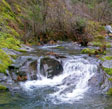| This article was published in the Independent Coast Observer on March 15, 2002. |
Courtesy Independent Coast Observer, Gualala, CA
Coastal and offshore waters are at risk from marine accidents that can release oil and other hazardous materials. Last week in Monterey a task force to reduce that risk reported to the California Coastal Commission.
Jean Cameron from Oregon, assisted by an officer of the U. S. Coast Guard, explained recent work of the Pacific States / British Columbia Oil Spill Task Force. The task force started work in 1989 and includes the states of Alaska, Washington, Oregon, California and Hawaii, and the Province of British Columbia.
The task force studied traffic patterns of different types of vessels and found that they generally stay 10 to 50 miles offshore, depending on the type of vessel. Patterns can very greatly with bad weather avoidance.
“A master will go where he or she needs to go for safety considerations or weather,” said Cameron. She said the coast of the lower 48 states is unforgiving, with few places for vessels to take shelter in severe weather.
The task force determined the ship transits for one year for each segment of the coast. This area saw 3,668 ship transits. The central California coastal segments saw more than 4,000, and the Los Angeles / Long Beach to San Diego segment saw 2,615. Cameron said that while the numbers will vary from year to year, the proportions are not likely to change.
While Cameron’s presentation was a brief overview and she did not mention the water bag transits proposed from this area to San Diego, the figures are of interest.
Several local people have calculated the number of trips needed for the proposed shipping of 30,000 acre feet per year from the Gualala and Albion Rivers to San Diego and they came up with about 1,200. [Note: This figure is not from one person, but a high-end average of the computations of several, including estimates for traffic from both rivers. JAV]
That would increase the ship traffic past these shores by about 25 percent, and increase the traffic in the southern segment by more than 40 percent.
While the cargo of water would not be hazardous in itself, the sheer number of trips could increase risk of marine accidents.
The Pacific States/ B.C. task force calculated onshore drift rates for disabled vessels at 0.2 to 1.3 knots per hour average, and 0.5 to 4.0 knots in the worst case.
They looked at more than 800 accidents involving vessels of 300 tons or more that occurred between 1992 and 1999 and found that 96 had the potential for a significant oil spill. Fishing vessels had the highest casualty rate.
Cargo freight vessels had the highest number of accidents, but the lowest rate, because there are many more of them.
They looked into the availability of tugs capable of rescue operations. They examined risk factors by area and by type of vessel. Risk is higher in winter. Single hull laden oil tankers and fishing vessels had the highest risk; freight barges the lowest. Most casualties take place near major ports.
The task force recommends expediting double-hull requirements for oil tankers and continuing an inspection program.
The goal of the task force is “real environmental protection, not just the appearance of it,” Cameron said.
The task force recommends advising mariners in severe weather of the safe distance off shore.
“The closer you get to shore, the higher the risk,” said Cameron. The task force is asking the Coastal Commission’s help with conveying this to vessel operators
To view Cameron’s 2001 Interim Report on the West Coast Offshore Vessel Traffic Risk Management Project, go to http://wlapwww.gov.bc.ca/eeeb/taskforc/vesselrept2.htm.
For the Pacific States/B.C. Oil Spill Task Force home page, go to http://wlapwww.gov.bc.ca/eeeb/taskforc/tfhome.htm.
These are British Columbia government sites.
 Friends of Gualala River Protecting the Gualala River watershed and the species living within it
Friends of Gualala River Protecting the Gualala River watershed and the species living within it
